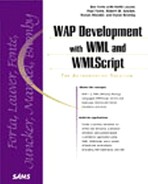Chapter 17. Scheduling
IN THIS CHAPTER
Wireless devices are intended to give their users real-time access to key information from virtually any location. Many existing "wired" PDAs and PIMs have succeeded in attracting a wide base of users by providing personal information, such as an address book, personal schedule, and to do lists, on portable devices. WAP devices can take that functionality one step further by "unwiring" those applications; using the network connectivity provided by WAP enables real-time updates by any user, anywhere. This could be especially useful for groups of users, such as families or companies, who share and co-manage different kinds of personal data. By maintaining the data (here, a personal schedule) on a server rather than on a handheld device, WAP offers a new methodology for schedule management. One way to look at this methodology is to conceptualize these applications as a kind of personal wireless portal.
To create these kinds of applications, which manage different types of data, we will need to connect our front-end WML-based interface with a back-end database. These are exactly the same kinds of databases that drive the most commonly used Web sites on the Internet—such as Amazon.com and the Internet Movie Database. Both of those sites, and many other of the major sites on the Internet, are useful precisely because they offer ways to view, sort, and search enormous amounts of data.
The thing that makes these sites capable of handling that kind of data is a back-end relational database. And, while these sites have huge data structures and data-management systems, you can develop your own small databases for WAP applications to offer a wide variety of functionality. For example, you might
Keep track of a project's progress when the participants are in different locations.
Create a dynamically generated WAP site that allows users to post messages about common interests.
Keep track of the movements and whereabouts of a certain group of people, like employees, friends, or family members.
Catalog every WAP site in a certain language or on a certain topic.
Create searching and sorting functionality for your WAP site.
In short, there are many kinds of applications that can benefit from database functionality, and now we are going to begin creating one. This chapter will walk you through the construction of a basic scheduling application which draws its data from a database.
